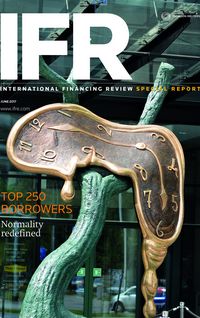Reality proving different from the worst of the apprehensions as business carries on regardless.
When Argentina rushed to sell US$7bn of bonds in the days before Donald Trump’s inauguration, it underscored concerns among Latin American borrowers that access to hard currency debt markets was likely to be severely curtailed as the incoming US administration took office and the risk of heightened volatility choked off investor demand for emerging market assets.
So far, such concerns are looking overblown.
Latin American borrowers had sold US$61bn of foreign currency-denominated bonds year-to-date the end of May, roughly in line with what they had sold during the same period in 2016, according to Dealogic. Excluding China, that is the most from any emerging market region. At the same time, average yields on Latin American US dollar bonds had fallen to 6.50% at the end of May from almost 7.20% at the start of the year, according to a JP Morgan index.
That brighter backdrop in Latin America came as investors reassessed Donald Trump’s position on trade and the protectionist policies that had been such a central thesis to his presidential campaign, deciding that much of what he had promised was bluster.
“There’s more of a sense now that the trade rhetoric from Trump is more rhetoric than substance, and that gives people comfort going into emerging markets more broadly but also in particular Mexico and Latin America,” said Anujeet Sareen, a fund manager at Brandywine Global.
With sentiment improved, companies have been rushing to lock in funding while rates remain low. Corporate borrowers accounted for just under two-thirds of the US$61bn sold in the first five months of the year.
“There has been quite a bit of liability management going on, given that some of the companies like Pemex and Petrobras had a lot of short-term maturities,” said Robert Carlson, head of debt capital markets for Latin America at MUFG Securities.
Meantime, sovereign borrowers have been accelerating their debt issuance plans this year as they seek to mitigate any potential impact from Trump and his domestic reform ambitions.
“Issuance tends to be front-loaded, but this year it has been even more front-loaded because of the Trump factor - and the Trump factor was ostensibly the agenda of a large fiscal stimulus that was going to push interest rates higher,” said Donato Guarino, an emerging market strategist at Citigroup.
Given that Trump’s stimulus efforts are likely to move at a much slower pace, Latin American borrowers are expected to continue taking advantage of the more benign market environment.
“We are in a pretty good window now because we have the combination of the Fed leaving a little bit of space to become more hawkish next year and, on top of that, all the political noise in the US pushing back and delaying any kind of fiscal stimulus. So, for an issuer, doing it over the next few months is going to be much better than doing it any time next year,” said Alvaro Vivanco, fixed income strategist for Latin America at BBVA.
Political risk
But Latin America is not without its challenges. In mid-May, a fresh political crisis erupted in Brazil, after President Michel Temer was accused of bribery. It is the latest reminder that political risk is never far from bubbling over in a region that has endured a wave of political crises in recent years, not least in Venezuela, where economic mismanagement has led to food shortages and mass protests.
“There’s always been political risk there; of all the regions it has always been pretty elevated given the distortions and imbalances in some of these economies, and Venezuela is the poster child for that,” said Kevin Daly, a fund manager at Aberdeen Asset Management.
But just as Venezuela’s turmoil has had little direct impact on other Latin American economies and their bond markets, investors are confident that the political storm in Brazil is unlikely to cause much contagion among its neighbours, even if the initial shock caused the region’s bond prices to momentarily wobble (average yields jumped around 10bp higher, before quickly receding).
“It’s still early days in this, but the difference between the latest Brazil news and what we saw in 2015 [when impeached former president, Dilma Rousseff, faced corruption accusations] is that the market has been through this already,” said Mark Hughes, a fund manager and research analyst on Western Asset Management’s emerging market debt team.
“When Brazil was junked in September 2015 and people were concerned about the ability of Petrobras to refinance its debt, that really bled into other parts of the emerging market space. But this time the spillover has been muted, and that is because people have seen this show before.”
And even though sentiment is weaker in the near term, some investors say the long-term outlook for Brazil remains intact.
“It probably means Temer’s reforms won’t go through as quickly, but it doesn’t really derail or change any of the overarching trends about why you would want to own Brazilian bonds,” said Brandywine Global’s Sareen.
Bankers reckon the back-up in Brazilian asset prices would likely increase demand for any new debt sales.
“Given the way new supply has been absorbed this year, if Brazil was to do any new issuance, at these kind of levels it would do pretty well,” said Guarino at Citigroup.
Other potential political headwinds in Latin America are on the horizon.
Argentina - where second-year president Mauricio Macri is overseeing a raft of economic reforms - faces mid-term elections in October that could hamper that reform push if Macri’s minority Propuesta Republicana party loses seats. And a presidential election in Mexico next year could see the country lurch to the left if populist candidate Andres Manuel Lopez Obrador is victorious at the polls.
“If Lopez Obrador wins and there is a new policy environment for Mexico, that could derail some of the good performance it’s had over the last 20 years. That is not our base case scenario, but it’s a market risk,” said Vivanco at BBVA.
Wider influences
But some investors also stress that the rise of Donald Trump and other populist movements gaining momentum elsewhere in the developed world shows that political risk is no longer exclusive to emerging markets.
“A fair amount of political risk is coming from outside emerging markets for once - Brexit, the US elections, the French elections; the playing field has been levelled to some extent,” said Emil Babayev, a fund manager at JP Morgan Asset Management.
External risks, however, continue to pose the biggest threat to the region. Given that the Latin American economy as a whole is largely driven by oil and mining exports, commodity prices remain central to its outlook. An economic collapse in China, for instance, would be destabilising for much of the region.
US interest rate rises also remain a perennial concern. While a slow, well-telegraphed hiking cycle is unlikely to cause much pain, if the Federal Reserve were to deviate from expectations and crank rates higher more rapidly, that could hurt borrowers if investors scamper for the emerging market exits.
“If rates increase, and continue to increase, and people pull money out funds, it becomes about not just which countries will be better off or could sustain higher interest rates, it is really more a question of how much money investors have to pull out,” said Carlson.
Indeed, anything that pushes 10-year US Treasury yields higher could see flows come under pressure, market watchers say. Emerging market flows were positive in all but one of the first 21 weeks of the year, Lipper data show.
“The risk is you get this wave of positioning that has been fairly strong over the last couple of months, and then you get a pull-back because everything reprices,” said Vivanco.
A massive sell-off such as the one suffered during the taper tantrum back in 2013 is unlikely to be repeated though, Vivanco said, as many investors who missed the current rally would see any fall in prices as an opportunity to buy more bonds.
Some money managers would even welcome a spot of market turbulence.
“Sometimes, a little volatility in the market or a specific issue like Brazil can slow things down a little bit and cause the ravenous appetite of investors for new issues to slow down. And that, in the medium term, can be good for us on the investor side because we can have a better selection of issuers coming to us, and probably at fairer valuations,” said Western Asset Management’s Hughes.
Many borrowers are also in a healthier position to manage any deterioration in external financing conditions than they were in the past, while a rise in US interest rates is not necessarily bad news for these economies either.
“Latin America has become more insulated [to a rise in US rates] because even the main players like Mexico or on-the-margin countries like Peru have been doing the right things by issuing less abroad in dollars and issuing more locally,” said Babayev at JP Morgan Asset Management.
“That has always been the Achilles’ heel in general. But as long as the rate rises are orderly and gradual and underpinned by good growth in the US, then the reflation theme should benefit Latin America.”
To see the digital version of this special report, please click here
To purchase printed copies or a PDF of this report, please email gloria.balbastro@tr.com



